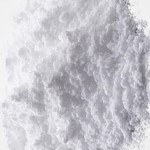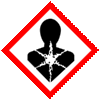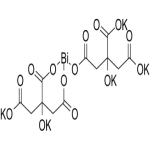Bismuth Subcitrate Potassium SDS of Suppliers Exporters, Manufacturers
Bismuth Subcitrate Potassium
CAS Number: 880149-29-1, Suppliers Exporters, Manufacturers

Please visit Main Page of Bismuth Subcitrate Potassium Manufacturers.
Bismuth Subcitrate Potassium SDS, Safety Data Sheet
MSDS Sheet 07-May-22
Section 1. Product Information
Product Name & Other Names: Bismuth subcitrate potassium.
CAS No.: 880149-29-1
EINECS EC Number: Not available
Relevant uses and uses advised against (if any): Industrial Manufacturing.
Suppliers: As per letterhead.
Section 2: Hazards Identification
GHS, Globally Harmonized System Classification in accordance with 29 CFR 1910
Classification according to Regulation (EC) No 1272/2008
Specific target organ toxicity - repeated exposure (Category 2), H373
Acute aquatic toxicity (Category 3), H402
Labelling according to GHS USA & Regulation (EC) No 1272/2008
GHS Label Elements  Health Hazard |
Signal Words: Warning
Hazard statements:
H373: May cause damage to organs through prolonged or repeated exposure.
H402: Harmful to aquatic life.
Precautionary statements:
P260: Do not breathe dust/fume/gas/mist/vapors/spray.
P270: Do not eat, drink or smoke when using this product.
P273: Avoid release to the environment.
P280: Wear protective gloves/protective clothing/eye protection/face protection.
P312: Call a POISON CENTER or doctor/physician if you feel unwell.
P314: Get medical advice/attention if you feel unwell.
P301+P312: IF SWALLOWED: Call a POISON CENTER or doctor/ physician if you feel unwell.
P302+P352: IF ON SKIN: Wash with plenty of soap and water.
P304+P312: IF INHALED: Call a POISON CENTER or doctor/physician if you feel unwell.
P304+P340: IF INHALED: Remove victim to fresh air and keep at rest in a position comfortable for breathing.
P305+P351+P338: IF IN EYES: Rinse cautiously with water for several minutes. Remove contact lenses, if present and easy to do. Continue rinsing.
Section 3: Composition and Information on Ingredients
Product Name & Other Names: Bismuth subcitrate potassium.
CAS No.: 880149-29-1
Section 4. First Aid & Procedure
Always get medical attention after the first aid is over.
Ingestion: Induce vomiting if directed by medical personnel. Never give anything by mouth to an unconscious person. Get medical attention.
Skin: Immediately flush skin with plenty of water for at least 15 minutes. Remove and wash contaminated clothing and shoes before reuse. Get medical attention if irritation develops.
Eyes: Immediately flush eyes with plenty of water for 15 minutes, occasionally lifting upper and lower eyelids. Hold eyelids apart during irrigation. Get medical attention.
Inhalation: Remove person to fresh air. If breathing is difficult, give oxygen. If not breathing administer artificial respiration. Get medical attention.
Section 5. Fire Fighting Measures
Flash Point: N/A
Extinguishing Medium: Water fog or other medium appropriate to surrounding fire conditions.
Extinguishing Media Not recommended: Avoid using solid water jet as it may scatter the fire.
Special Information: In the event of a fire, wear full protective clothing and NIOSH-approved self-contained breathing apparatus with full face piece operated in the pressure demand or other positive pressure mode. At elevated temperatures under fire conditions, it may produce toxic or irritating fumes. Fire-extinguishing work is done from the windward and the suitable fire-extinguishing method according to the surrounding situation is used.
Section 6. Spills and Disposals
Personal precautions, protective equipment, and emergency procedures: Avoid breathing dust/fumes/gas/mist/vapors/spray. Use individual protective equipment (waterproof boots, suitable protective clothing, safety glasses, etc.). Do not approach facing the wind.
Environmental precautions: Do not let the product enter drains, soil, or water sources.
Methods and materials used for containment cleanup procedures and Storage: Pick up and arrange disposal without creating dust. Contain spilled material. Do not let the product enter drains. Use a shovel to put the material into a convenient waste disposal container. Finish cleaning by spreading water on the contaminated surface and allow evacuating as per law.
Section 7. Handling and Storage
Precautions for safe handling: Apply according to good manufacturing and industrial hygiene practices. Ensure proper ventilation. In case of insufficient ventilation, wear suitable respiratory equipment. Wash thoroughly after handling. Do not drink, eat, or smoke while handling. Avoid contact with skin, eyes, and clothing. Minimize dust generation. Avoid breathing dust/fumes/gas/mist/vapors/spray. Use individual protective equipment (waterproof boots, suitable protective clothing, safety glasses, etc.).
Conditions for safe storage, including any incompatibilities: Store in cold, dry, and ventilated area away from heat sources and protected from sunlight in tightly closed original container. Keep air contact to a minimum. Store protected from heat, sparks and ignition sources and incompatible materials. Do not store with incompatible materials like strong oxidizing agents, strong acids, and alkalis.
Section 8. Exposure Controls & Personal Protection
Exposure Limits: Not established.
Engineering Controls: Use adequate exhaust ventilation to keep airborne concentrations low.
Ventilation System: A system of local and/or general exhaust is recommended to keep employee exposures as low as possible.
Personal Respirators (NIOSH Approved): For conditions of use where exposure to dust or mist is apparent and engineering controls are not feasible, a particulate respirator may be worn.
Skin Protection: Wear protective gloves and clean body-covering clothing.
Eye Protection: Use chemical safety goggles and/or full-face shield where dusting or splashing of solutions is possible. Maintain eye wash fountain and quick-drench facilities in work area.
Other Control Measures: Maintain good housekeeping in work area. Handle in accordance with good industrial hygiene and safety practice.
Section 9. Physical & Chemical Data
Appearance: Solid. White to off-white powder.
Odor: Odorless
Odor threshold: No applicable.
pH Value: No data found.
Relative density: No data found.
Melting Point: No data found.
Boiling Point: No data found.
Flash point: No data found.
Decomposition: No data found.
Decomposition temperature: No data found.
Upper/lower flammability or explosive limits: No data found.
Vapor pressure: No data found.
Vapor density: No data found.
Evaporation rate: No data found.
Flammability (solid, gas): No data found..
Partition coefficient: n-octanol/water: No data found.
Solubility: Soluble in liquor ammonia.
Viscosity: No data found.
Formula: C12H8BiK5O14 for Anhydrous and C12H14BiK5O17 for Trihydrate
Chemical Formula: 782.67 for Anhydrous.
Section 10. Stability and Reactivity
Chemical Stability: Stable under normal temperatures and pressures.
Incompatibility (Materials to Avoid): Strong oxidizing agents, , strong acids and alkalis.
Conditions to Avoid: Incompatible materials, exposure to moist air or water, excessive heat.
Hazardous Decomposition Products: Carbon dioxide, oxides of bismuth and potassium.
Hazardous Polymerization: Will not occur.
Section 11. Toxicological Information
Toxicity to Animals: No data found.
Carcinogenicity: No component of this product present at levels greater than or equal to 0.1% is identified as possible or confirmed human carcinogen by IARC, ACGIH, OSHA and NTP.
Teratogenic Effects: No data found.
Mutagenic Effects: No data found.
Developmental Toxicity: No data found.
Reproductive Effects: No data found.
Section 12. Ecological Information
Toxicity to fish: No data found.
Persistence and Degradability: No data found.
Mobility: No data found.
Bioaccumulation/ Accumulation: No data found.
Results of PBT and vPvB assessment: No data found.
Section 13. Disposal Suggestions
Dispose of in accordance with all applicable local, state, and federal regulations at an approved waste disposal facility.
Section 14. Transport and Label Information
DOT USA, TDG Canada & ADR/RID Europe: Not regulated.
IMDG/IMO: Not regulated.
IATA/IMO: Not regulated.
Section 15. Regulatory Information
USA:
SARA 311/312 Hazards: See section 2 .
California Prop. 65 Components: This product does not contain any chemicals known to State of California to cause cancer, birth defects, or any other reproductive harm.
Section 16. Other Information
DISCLAIMER: The information and recommendations set forth herein are presented in good faith and believed correct as of the date hereof. It is compiled from various sources, and it is not necessarily all inclusive nor fully adequate in every circumstance. In addition, these suggestions should not be confused with nor followed in violation of applicable laws, regulations, rules, or insurance requirements applicable. This MSDS sheet is intended only as a guide to the appropriate precautionary handling of the material by a professionally trained person using this product. Individuals receiving the information must exercise their independent judgment in determining its appropriateness for a particular purpose.

Please visit Technical Data Sheet of Bismuth Subcitrate Potassium Suppliers.
Bismuth Citrate CAS Number 813-93-4 & Bismuth Subcitrate Potassium CAS Number 880149-29-1 Supplier Exporter, Manufacturer:
Annie Chemie P Ltd
Mumbai 4000010, INDIA
With Agents and offices in UAE, USA, Europe.
e-mail: info@anniechemie.com
Copyright and Usual Disclaimer is Applicable.
May 29, 2025
Exporters to USA, Canada, UK, Europe, UAE, Nigeria, Algeria, Turkey, Mexico, Brazil, Chile, Argentina, Australia, Dubai etc.
Perfection is made up of small things and that is a big thing.
